How Country Music Took Over the Charts: A Statistical Analysis
Unpacking the meteoric rise of country music.
Intro: What is "Old Town Road"?
In March of 2019, Billboard removed Lil Nas X's "Old Town Road" from its Hot Country chart after allowing the track to reach the #19 spot, claiming the song didn't "fit" the modern country genre. "Old Town Road" bore several hallmarks of country music—including banjo instrumentation, lyrical nods to cowboy life, and vocals delivered with a western twang—yet its propulsive trap beat and rap-inflected lyrical delivery drew from hip-hop.
The song's removal sparked widespread debate about what defines country music: is the genre distinguished by its artists, lyrics, instrumentals, where it's produced, or some ambiguous combination of these parameters?
Ultimately, Billboard's reclassification of "Old Town Road" reflects broader anxieties about the mainstreaming of country music and the sonic reinvention that comes with cultural ubiquity. In 1975, 6% of Billboard-charting songs were categorized as country; by 2023, this figure had increased to 34%, making country the most popular genre on Billboard’s year-end Top 100 chart.
Historically, country listeners have been among music's most distinctive fanbases—exceptionally devoted, relatively insular in taste, and overwhelmingly concentrated in the United States. As country music continues its mainstream ascendency, how far will this long-running genre stray from its traditionalist roots—and is there historical precedent for this shift?
So today, we'll explore what makes country music and its fanbase so unique, examining the genre's growing cultural footprint and consistent reinvention.
What Makes Country Music So Unique (and So Average)?
Country music originated in the 1920s as "hillbilly music," rooted in the rural folk traditions of Appalachia and primarily consumed by working-class, rural Southerners. (To be clear, "hillybilly music" wasn't a casual nickname; major labels like Columbia explicitly promoted artists using this terminology.)
The term "hillbilly music" was gradually replaced by "country music" during the 1940s as the genre expanded its mainstream appeal, with musicians such as Hank Williams and Patsy Cline becoming radio staples. Country artists such as Jim Reeves and Hank Locklin appeared in Billboard's inaugural Hot 100 ranking in 1958, and the genre has remained a fixture of the charts for over seven decades. This sustained presence makes country the longest-tenured genre on the Billboard Hot 100, outlasting contemporaneous styles such as jazz and pop standards, and predating modern formats like hip-hop and R&B.
Music historians recognize sufficient cultural and stylistic continuity between "hillybill music" of the 1920s and modern artists like Morgan Wallen, viewing these acts as part of a single, continuous genre.
Country music's remarkable longevity can be attributed, in part, to its exceptionally loyal fanbase. According to data from AccuRadio, country listeners overwhelmingly concentrate their streaming activity on country channels, demonstrating a dedication unmatched by fans of other styles.
Country's cultural endurance can be credited to its wide-ranging appeal: the genre is deeply connected to physical place (the American South and Midwest), evokes a distinctive lifestyle (cowboy or rural living), employs a variety of stylistic signatures (banjo, steel guitar, and fiddle), and traditionally resists chasing the attentions of youth culture.
Despite the genre's burgeoning popularity in Canada, Australia, and other English-speaking nations, country music remains a distinctly American art form. Among AccuRadio users, country channels attract a large share of listenership from the United States, outpaced only by Christian, Christmas, and Broadway channels.
While country listeners are uniquely devoted, demographically, they increasingly mirror mainstream America.
Critics have long stereotyped country fans due to historical prejudices against the genre. Yet, a 2018 poll from the (probably-somewhat-biased) Country Music Association suggests that today's listeners are, statistically speaking, pretty much the average American. (Admittedly, the "average American" is an elusive media construct endlessly dissected in New Yorker think pieces to the point of losing all semiotic credibility, so here "average" is merely a statistical term.)
Two aspects of this poll are fascinating:
Most likely, the Country Music Association circulated these statistics to dispel persistent stereotypes about country consumers (as if the caricature-esque "hillybilly music" label never dissipated).
The survey was conducted within the last decade, and thus reflects a fundamental contradiction afflicting modern country music: can a genre historically sustained by insularity withstand mainstream adoption?
Enjoying the article thus far and want more data-centric pop culture content?
How Country Went Mainstream
The 1990s were a turning point for country's mainstream acceptance, driven by two mutually reinforcing phenomena:
Improved Telecommunication Infrastructure: The Telecommunications Act of 1996 enabled American media companies to consolidate regional stations into national networks, facilitating country radioplay outside of rural strongholds. Simultaneously, enhanced geographic radio coverage brought consistent access to underserved rural listeners. Together, these infrastructure improvements fostered a virtuous cycle: greater airplay propelled more country songs onto the charts, which in turn drove even more airplay.
Country Crossover Successes: Country crossovers like Garth Brooks, Shania Twain, and Tim McGraw blended conventional genre staples with accessible pop and rock influences, broadening the format's appeal beyond its traditional fanbase. Brooks was one of the best-selling artists of the 1990s, selling over 62 million albums in the United States—matched only by Mariah Carey and Celine Dion.
Together, these technocultural shifts expanded the genre's commercial footprint, enabling country to grab a larger share of Billboard’s Hot 100.
Over its 100+ year lifespan, country's adaptability has been its greatest strength, empowering new generations to evolve the genre's sound for contemporary listeners. Throughout my research, I was struck by the sheer number of country subgenres that have emerged (and faded) over the past sixty years, including southern rock, honky-tonk, cowpunk, bluegrass, countrypolitan, the Nashville sound, the Bakersfield sound, outlaw country, neotraditional country, Americana, bro-country, country pop, and (most recently) country hip-hop.
Among Billboard-charting songs released since 1958, country exhibits above-average diversity in song composition, surpassed only by folk and jazz (two formats that no longer appear on today's Hot 100).
This stylistic flexibility has uniquely benefited the genre in recent years, with established artists like Morgan Wallen and Florida Georgia Line incorporating rap-inspired 808 beats into their music and collaborating with hip-hop stars like Post Malone and Nelly, respectively. Additionally, the genre has welcomed an emerging wave of country-infused hip-hop acts, such as Lil Nas X and Shaboozey, who effortlessly blend styles in international hits like "Old Town Road" and "Tipsy."
Over the past seven years, country music has steadily climbed Billboard's year-end Top 100, regularly competing with pop for the top spot.
2024 marked a significant turning point for the genre's mainstream footprint, as major pop acts like Beyoncé and Post Malone released chart-topping country albums.
Three of the five best-selling country acts of 2024 previously operated (and charted) in different genres before minting hits on the Billboard Hot Country Songs chart.
Country music now sits at the center of culture, although this newfound prominence is not without complication. The genre has remained relevant for over a century due to its adaptability and the deep-seated loyalty of its fans. But as country music gains broader acceptance among everyday listeners, how significantly will its sound evolve, and how will dedicated traditionalists who sustained the genre respond to this shift?
Final Thoughts: Country Cosplay
The Sex Pistols debuted in 1970s East London alongside British punk acts like The Clash and Buzzcocks. These bands collectively defined and popularized the punk aesthetic, characterized by stripped-down instrumentation, aggressive vocals, and a DIY ethos, along with provocative fashion marked by ripped clothing, safety pins, spiked hair, and leather jackets. These stylistic choices would become enduring symbols of youthful rebellion.
Fast forward to 2004, and any teenager can visit their local suburban mall to purchase a Sex Pistols t-shirt, leather jacket, or pair of ripped jeans at Hot Topic. Meanwhile, pop punk heir apparents like Green Day and Blink-182 are topping the charts with polished, commercial power ballads that vaguely resemble the Buzzcocks' sonic chaos. Punk is no longer a subversive movement or lifestyle; it has become a collection of commercial products offering the aesthetics of rebellion, absent genuine defiance.
This process is known as co-option, in which mainstream institutions commercialize countercultural art forms or subcultures, stripping them of their original meaning and diminishing their appeal to early adopters. There is no grand puppet master orchestrating these changes; instead, this transformation unfolds organically as tastemakers and teens adopt, reinterpret, and reshape the meaning of cultural iconography.
Some historical examples of co-option include:
College students buying t-shirts or posters of staunch anti-capitalist Che Guevara
N.W.A rapper Ice Cube parodying his menacing persona in children's movies
Hollywood commercially exploiting superhero comics and Star Wars, which were once tokens of outsider "nerd" culture
With mass consumption, a cultural symbol becomes a photocopy of a photocopy, gradually disconnected from its roots and forfeiting its expressive integrity (to varying degrees).
Here lies the fundamental paradox at the core of country's newfound visibility: the genre has always emphasized authenticity and celebrated a distinctive lifestyle, qualities that risk dilution as its appeal broadens. Soon, we may see teenagers wearing cowboy hats, bolo ties, and boots as pure cosplay, purchased at suburban malls nowhere near a horse, whiskey bar, or open plain.
Perhaps this explains why country tastemakers perceived "Old Town Road" as a threat: the song meme-ifies the country aesthetic, with an outsider playfully evoking hallmarks of the genre as mere spectacle. Or perhaps they anticipated how expansive the genre might become once blended with other musical styles, and wanted to keep that genie in the bottle. Well, clearly this move did not work.
To quote a line from Beyoncé's new country album: "Genres are a funny little concept, aren't they? … In theory, they have a simple definition that's easy to understand, but in practice, well, some may feel confined."
Struggling With a Data Problem? Stat Significant Can Help!
Having trouble extracting insights from your data? Need assistance on a data or research project? Well, you’re in luck because Stat Significant offers data consulting services and can help with:
Insights: Unlock actionable insights from your data with customized analyses that drive strategic growth and help you make informed decisions.
Dashboard-Building: Transform your data into clear, compelling dashboards that deliver real-time insights.
Data Architecture: Make your existing data usable through extraction, cleaning, transformation, and the creation of data pipelines.
Want to chat? Drop me an email at daniel@statsignificant.com, connect with me on LinkedIn, reply to this email, or book a free data consultation at the link below.
Want to chat about data and statistics? Have an interesting data project? Looking to produce data-centric editorial content? Email daniel@statsignificant.com


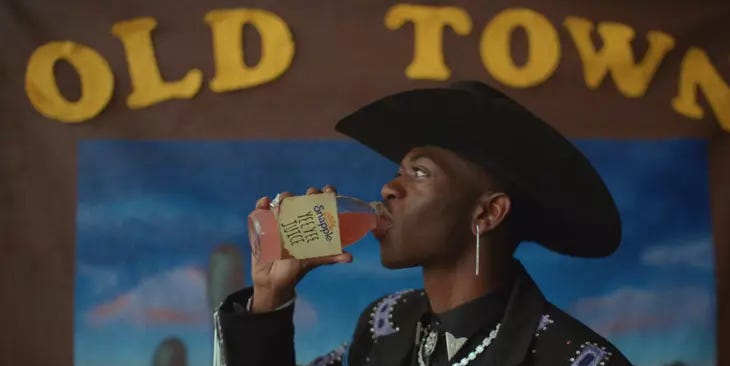
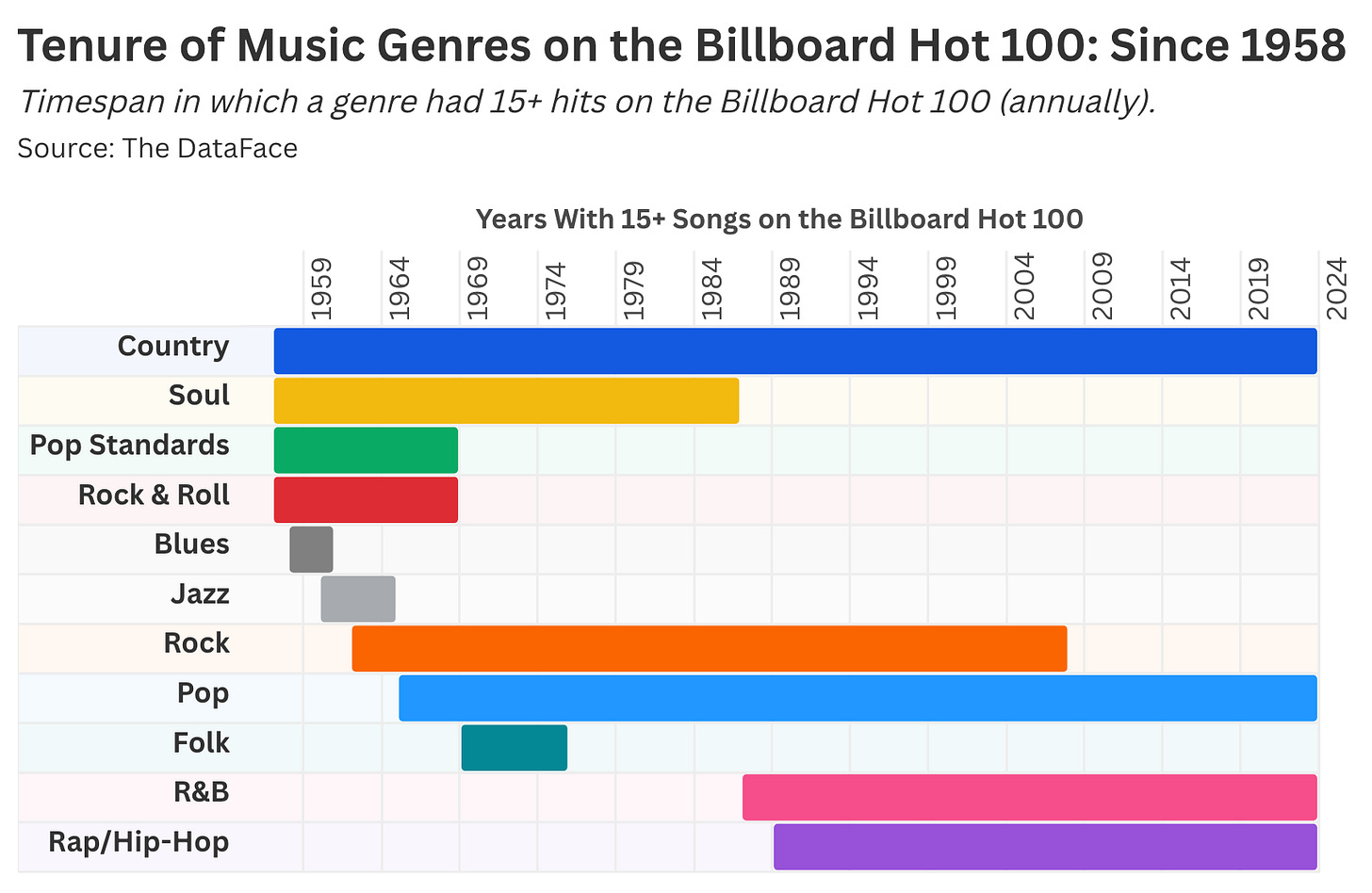
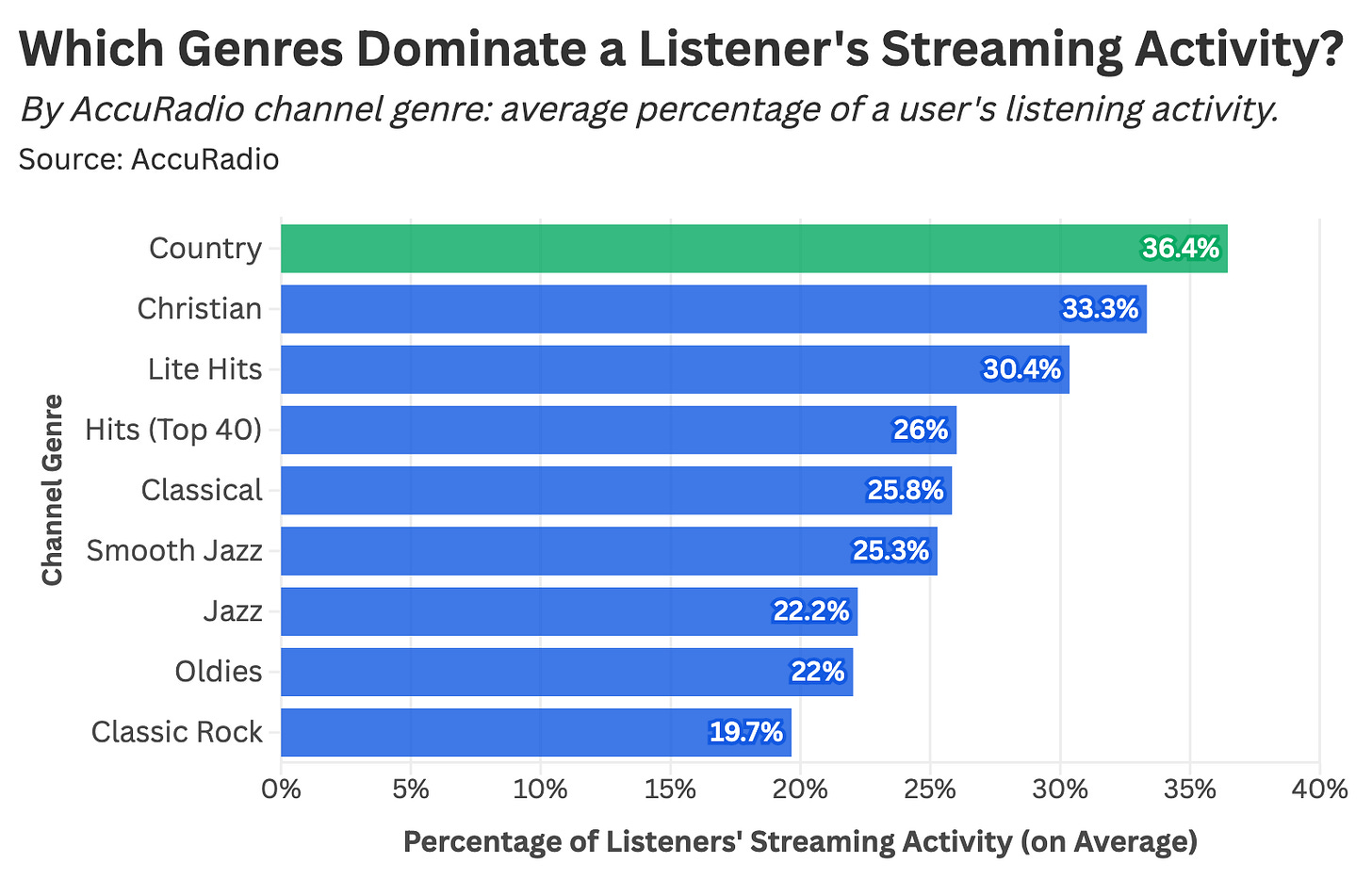
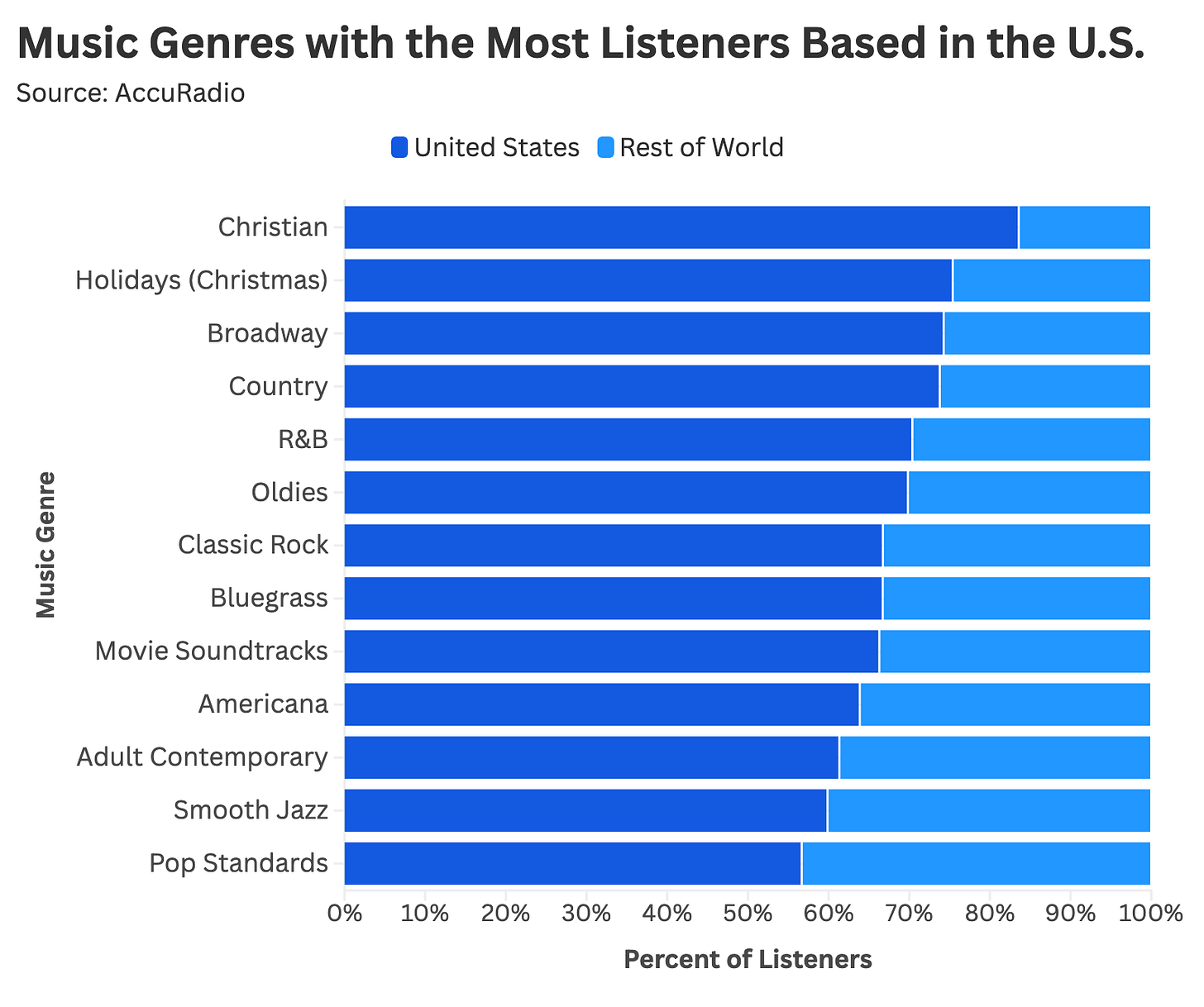

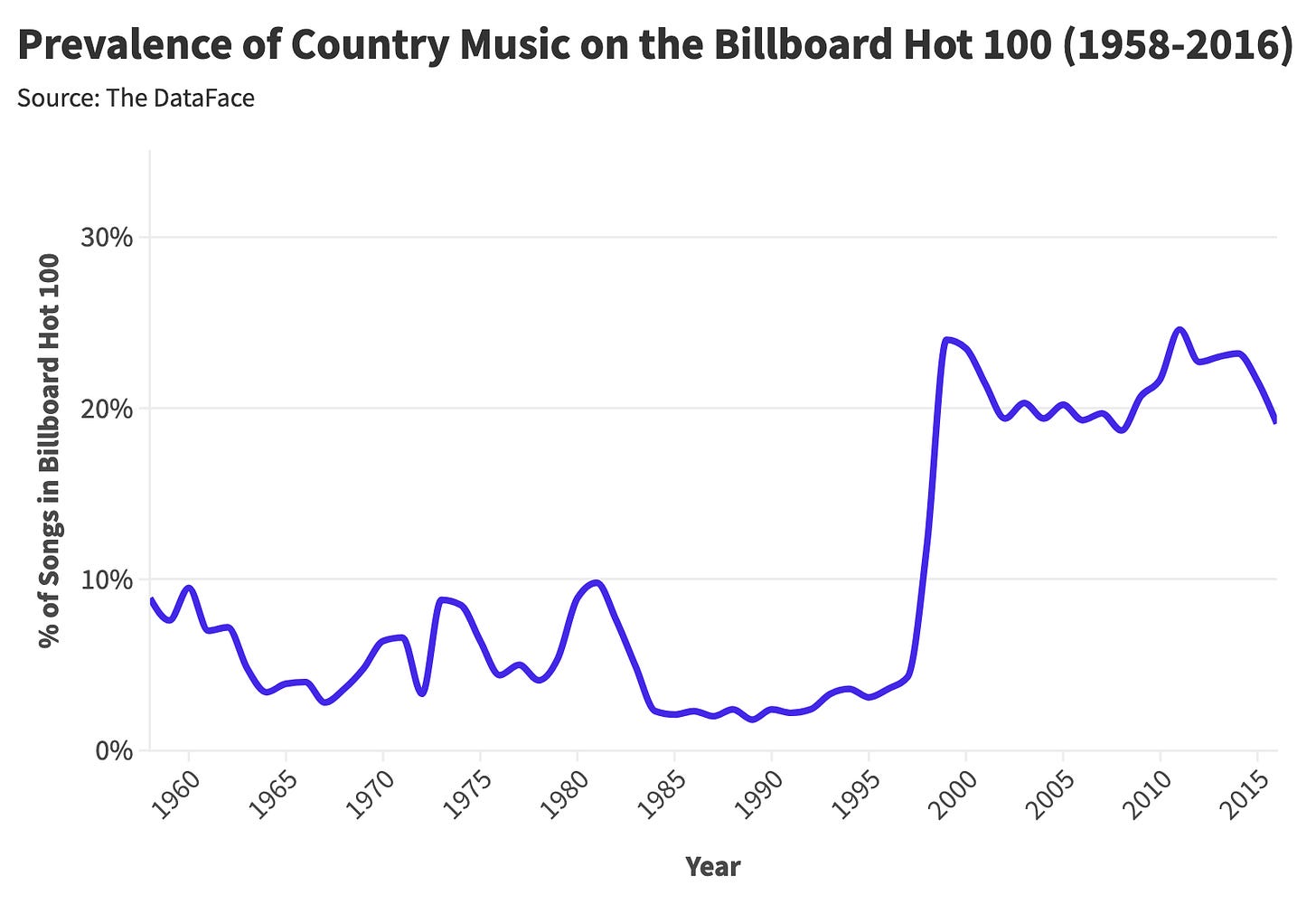
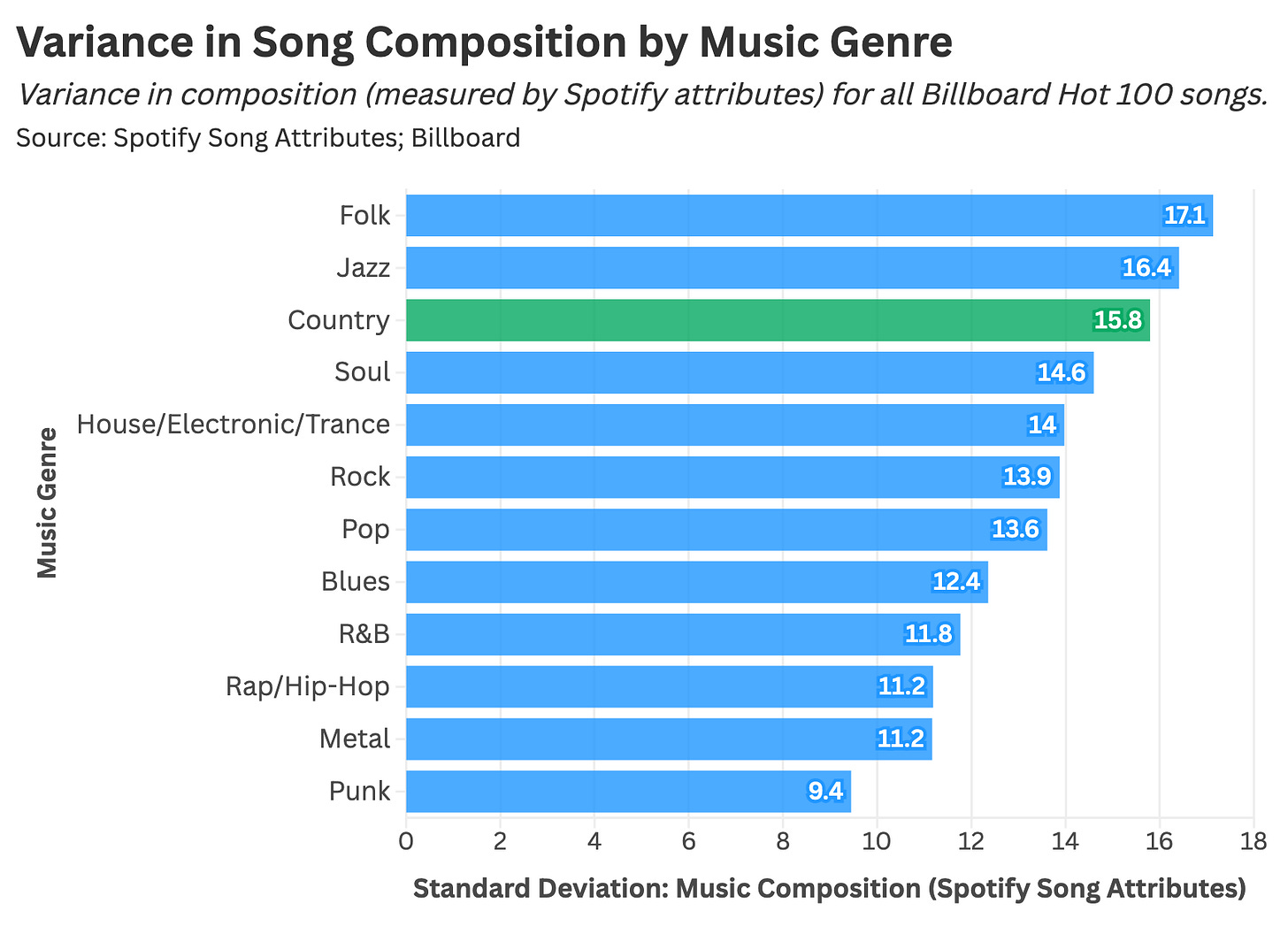
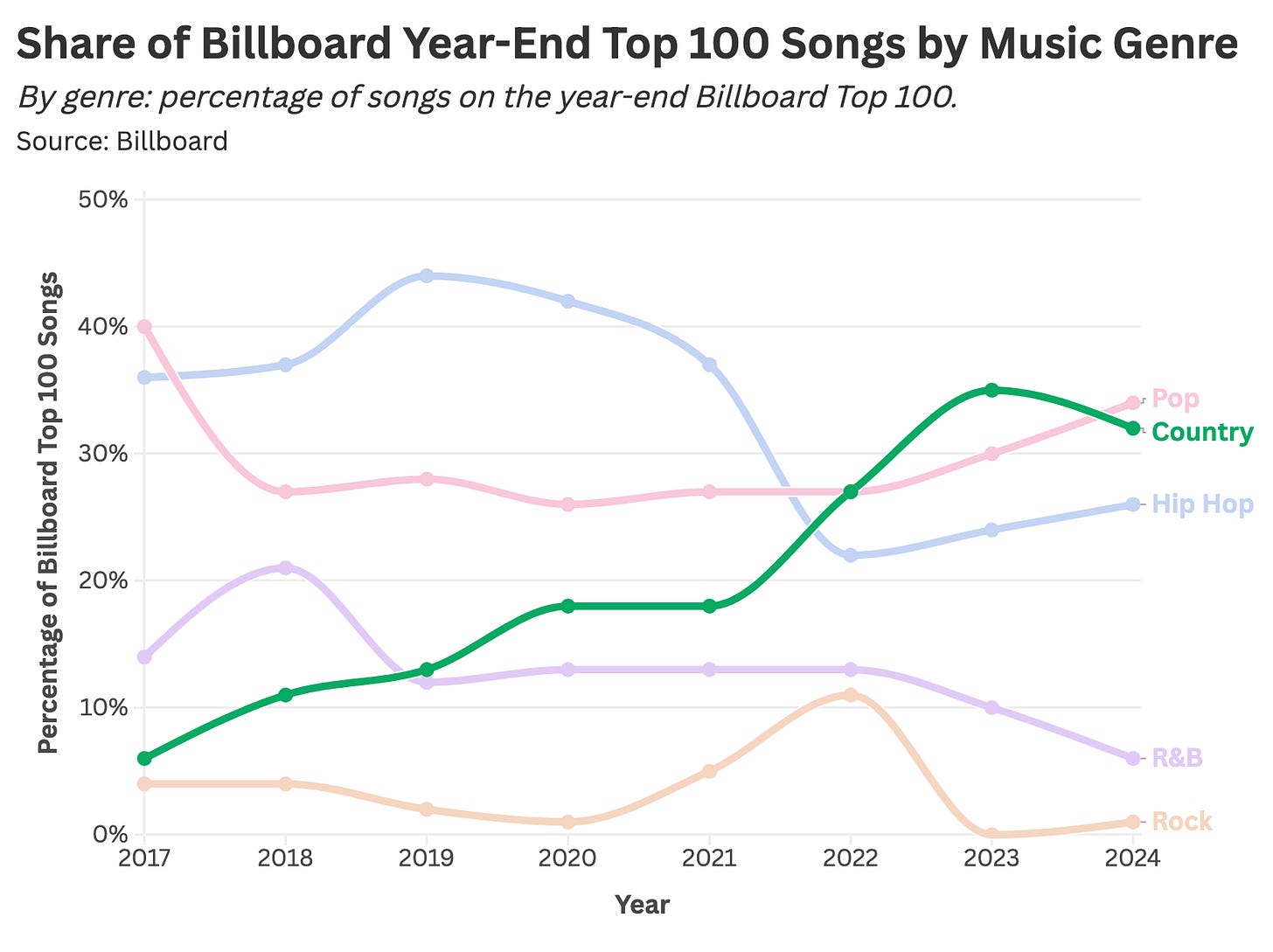
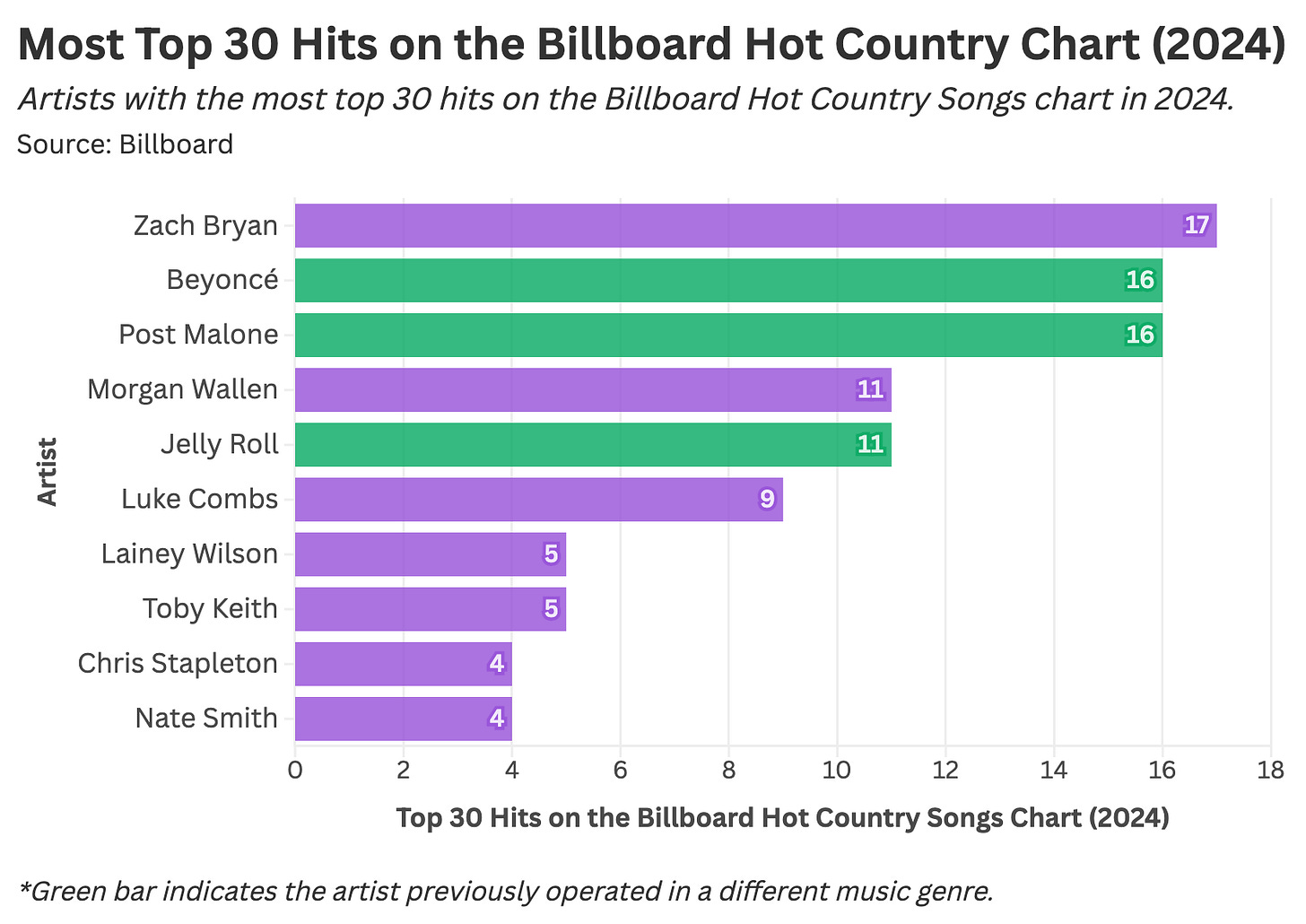
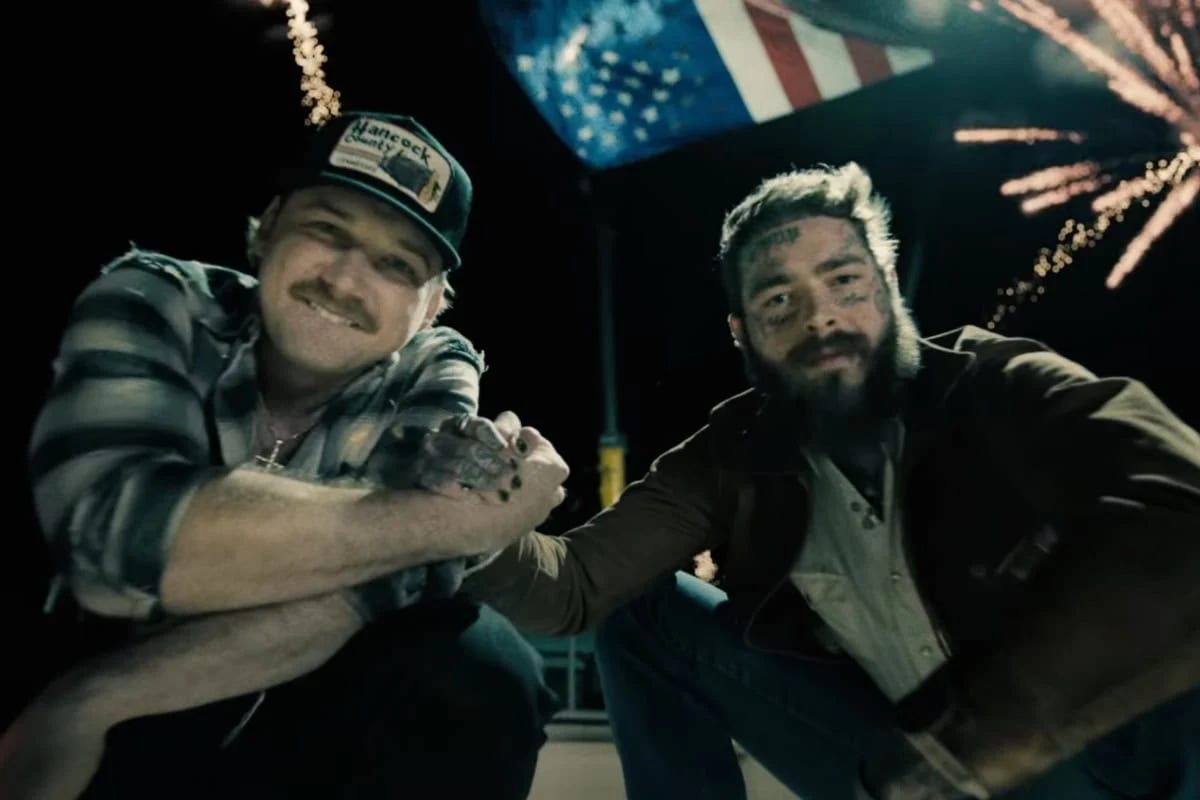

I may be wrong here but my theory is the popularity of country music spikes when it becomes trendy to dress and act below one’s social class. Cosplaying as poor, to put it pejoratively. Happened in the early 70s, mid 90s, and 2020s.
I think this misses an entire dimension of shifting consumer (and creator) demographics. Talking about how Black culture intersects with country-as-a-genre might be too daunting or just too involved for this article, but it should at least be acknowledged.
From a Stats perspective, I really would like to see how the racial demographics of big name creators has changed in various genres.
Thanks for what you do!